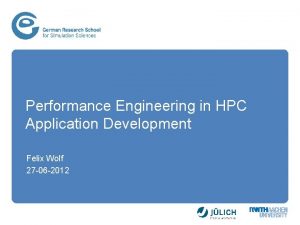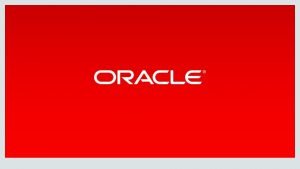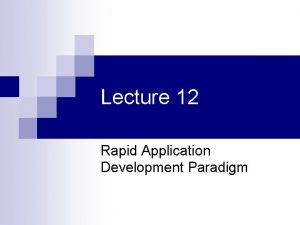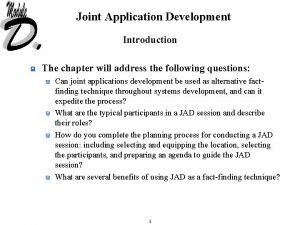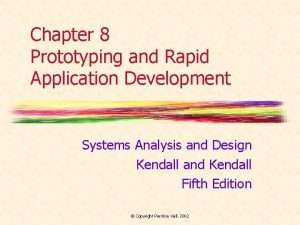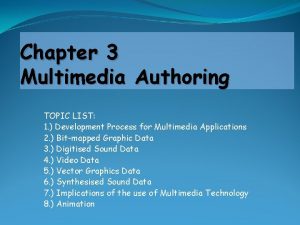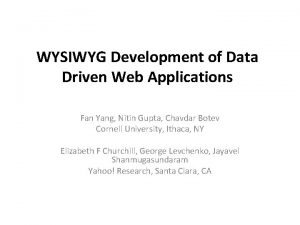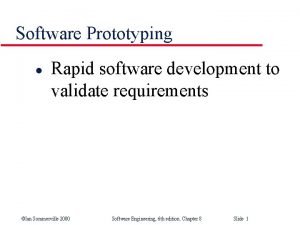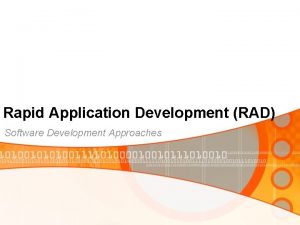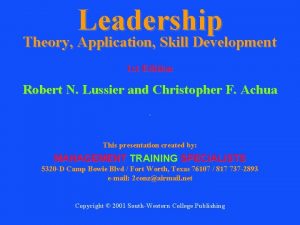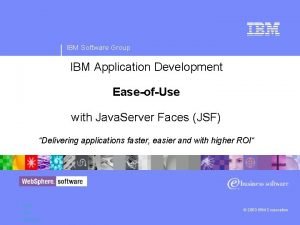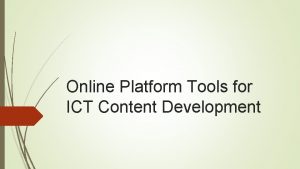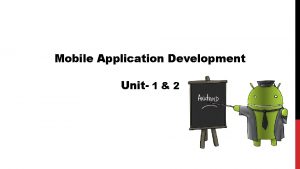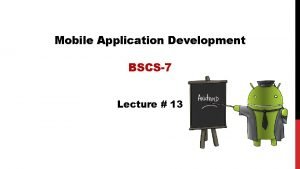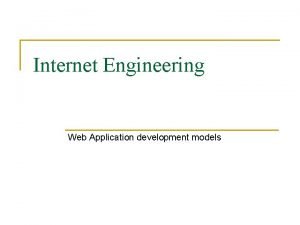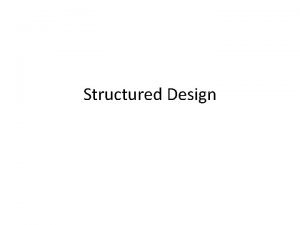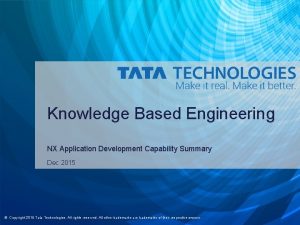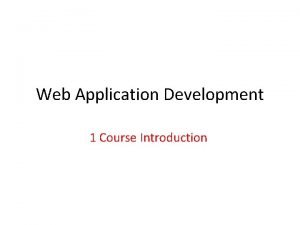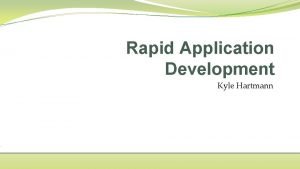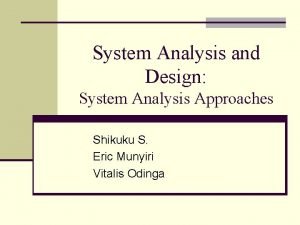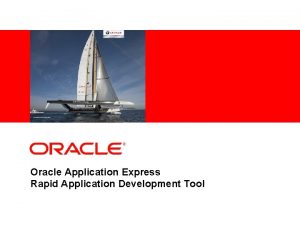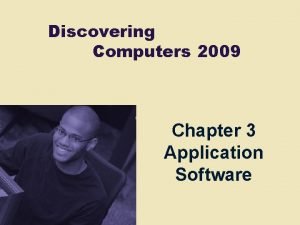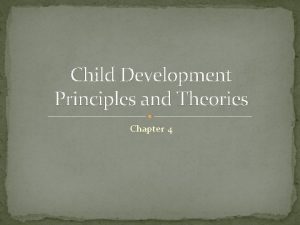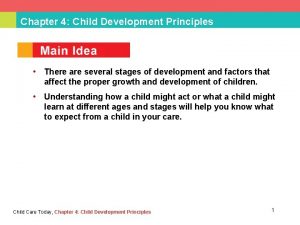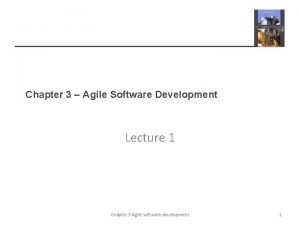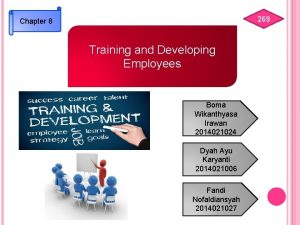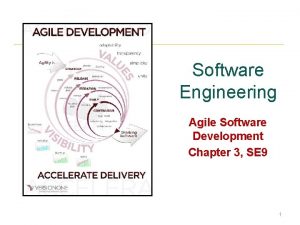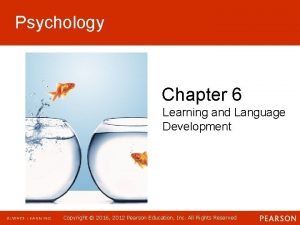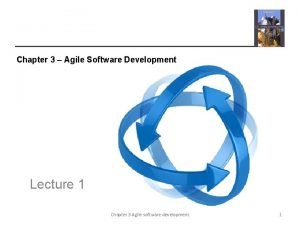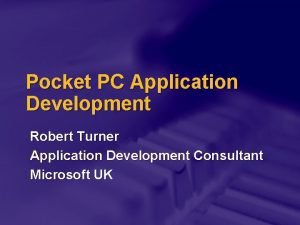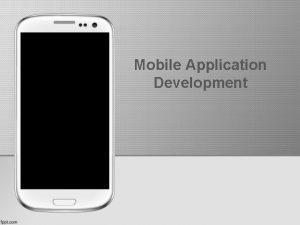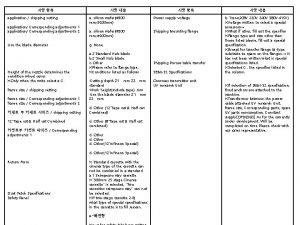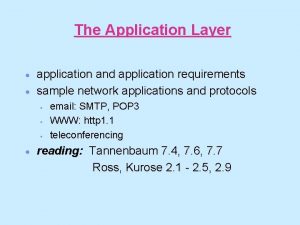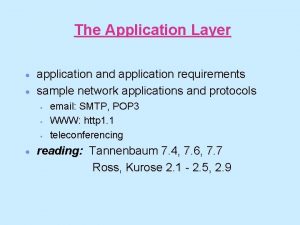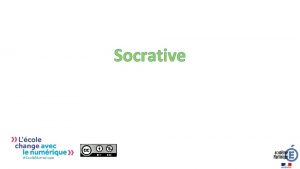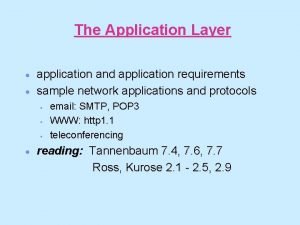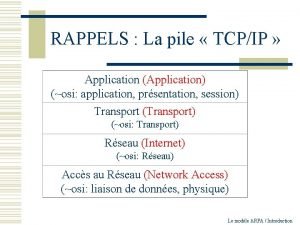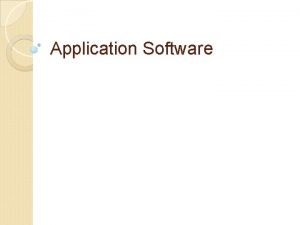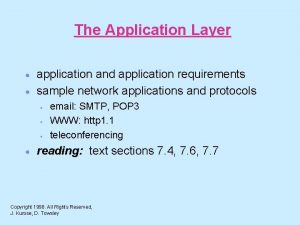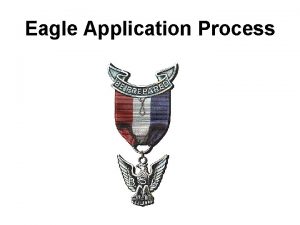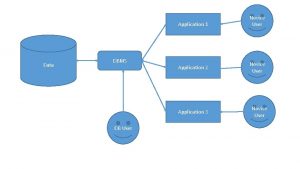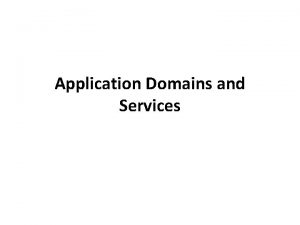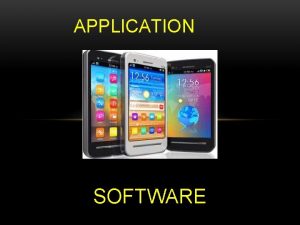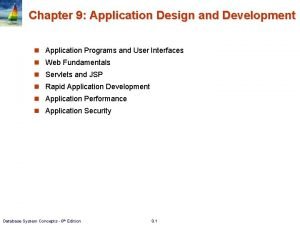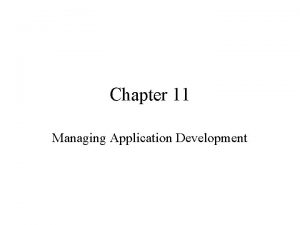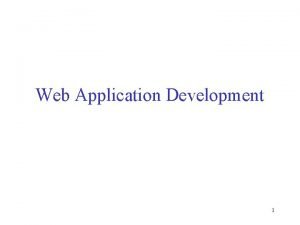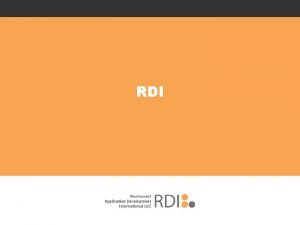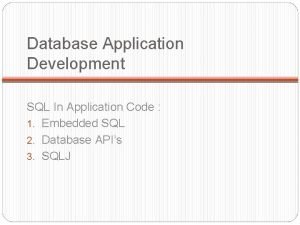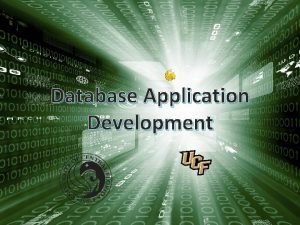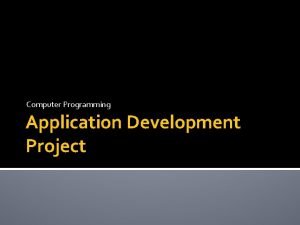Chapter 10 Application Development Chapter 10 Application Development
























































- Slides: 56

Chapter 10 Application Development

Chapter 10 Application Development Chapter Outline The Application Development Process Programming Languages Compilation Link Editing Interpreters Focus - Java Symbolic Debugging Integrated Application Development Tools Focus – Oracle JDeveloper Focus - Building the Next Generation of Application Software

Chapter Goals • Describe the application development process and the role of methodologies, models, and tools • Compare and contrast programming language generations • Explain the function and operation of program translation software, including assemblers, compilers, and interpreters • Describe link editing, and contrast static and dynamic linking • Describe integrated application development software, including programmer’s workbenches and CASE tools

Chapter 10 Application Development

The Application Development Process • Follows a development methodology • Develops a set of models • Uses automated tools

Application Development

Systems Development Life Cycle (SDLC) • Follow disciplines and iterations of the Unified Process (UP) • Usually includes two sets of models – System requirements model – Design model

The Unified Process (UP)

Methodologies and Models • Methodology – Integrated collection of models, tools, and techniques • UP employs object-oriented analysis, design, and deployment models • Class diagrams document user and system requirements

Tools • Wide array to support or completely automate software development tasks • Proper tool selection is a critical and difficult undertaking

This Material Continued In CIS 242 Introduction to Systems Analysis and Design 4 hours, 4 credits Study of a computer system life cycle via a structured approach: problem definition, feasibility study, cost estimation, analysis, design, implementation, testing and maintenance. Hardware and software organization. Several case studies will be considered. PREREQ: CIS 211.

Programming Languages • Instruct computer to perform a task • Sometimes called code • Programmer goals – Make language easier for people to understand – Develop languages and development approaches that require people to write fewer instructions to accomplish a task

Programming Language Evolution

Programming Languages • Summary of capabilities of recent generations – Instruction explosion – Database access – Support for GUIs – Nonprocedural programming • All but 1 GL must be translated into CPU instructions prior to execution (compilers and interpreters)

Programming Language Characteristics

First-Generation Languages • Required programmers to remember binary codes that represented each CPU instruction and to specify all operands as binary numbers • Tedious to program; error-prone

Second-Generation Languages • Use mnemonics to represent variables (program instruction memory address) and labels (data item memory address) • Easier to manipulate than binary numbers; assembler translates program into binary CPU instructions • Common in 1950 s

Third-Generation Languages • Use mnemonics to represent instructions, variables, and labels • Have degree of instruction explosion greater than 1: 1 • Translated with compilers, link editors, and interpreters • Machine independent • Developed before GUIs, database managers, and Internet

Fourth-Generation Languages • Majority were proprietary – many were optional components of database management systems • Most support mixture of procedural and nonprocedural instructions

Equivalent Programs in SQL and C

Fifth-Generation Languages • Nonprocedural language suitable for developing software that mimics human intelligence • Rule processor accepts a starting state as input and iteratively applies rules to achieve a solution • First appeared in 1960 s; not widely used until 1980 s

Object-Oriented Programming (OOP) Languages • View data and programs as two parts of integrated whole (object) • Promote reusability and portability of source code • Uniquely suited to developing real-time programs • Not clear successors to 5 GLs; neither nonprocedural nor exclusively used for developing artificial intelligence

OOP Languages Objects reside in a specific location, wait for messages to arrive, and return a response.

Scripting Languages • Enable programmers to develop applications that do most of their work by calling other applications and system software • Enable rapid assembly of application software by “gluing” together capabilities of other programs • Evolved from 4 GLs, though most now incorporate OOP concepts

Programming Language Standards • Set by ANSI and ISO • Include definitions of: – Language syntax and grammar – Machine behavior for each instruction or statement – Test programs with expected warnings, errors, and execution behavior • Guarantee program portability among operating systems and application programs

Compilation • Translates an entire source code file, building a symbol table and object code file as output

Program Development

Compiler 1. Checks for errors in syntax 2. Issues warnings and/or error messages 3. Builds and uses a Symbol Table as it works – stores information about data items and program components 4. Generates CPU instructions and library calls to carry out the source code instructions 5. Creates an object code file as output

Source Code Instruction Types Data declarations A data declaration creates an entry in the symbol table Data operations A data operation becomes a series of data transformation instructions Control structures A control structure becomes a series of control flow instructions Subprogram calls

Data Declarations • Define name and data type of program variables • Stored in memory allocated by compiler

Symbol Table The compiler updates a symbol table to keep track of data names, types, and assigned memory addresses.

Data Operations • Instructions that update or compute a data value • Translated by compiler into equivalent sequence of data movement and data transformation instructions for target CPU • Compiler refers to entries in symbol table to determine source and destination memory addresses for data movement instructions

Control Structures • Source code instructions that control the execution of other source code instructions • Common thread is transfer of control among CPU instructions

Function Calls • Named instruction sequences executed by call instructions • Transfer control to the instruction following the call by executing a return instruction

Implementing Call and Return Instructions • Compiler generates CPU instructions to: – Pass input parameters to the function – Save the value of the IP as a Return Address – Load the IP with the address of the subprogram – Transfer control to the function – Execute CPU instructions within the function – Pass output parameters back to the caller – Load the IP with the saved Return Address – Transfer control back to the caller

Symbol Table

Compilation Just The First Step source code translated by compiler into object code linked with library routines to make load module loaded into memory by operating system as runnable machine instructions

Link Editing • Statically links external reference calls in object code to library functions; combines them into a single file containing executable code • Can dynamically link external calls by statically linking them to an OS service function that loads and executes dynamiclink library (DLL) functions at run time • Always used by interpreters

Key Benefits of Link Editors in Program Translation • A single executable program can be constructed from multiple object code files compiled at different times • A single compiler can generate executable programs that run under multiple operating systems

Linking Separately Compiled Functions into a Single Program

Dynamic and Static Linking • Static linking – Library and other subroutines cannot be changed once inserted into executable code • Dynamic linking – Performed during program loading or execution

Advantages of Dynamic and Static Linking • Dynamic – Smaller application program executable files – Flexibility • Static – Execution speed – Improves reliability and predictability of executable programs

Interpreters • Interleave source code translation, link editing, and execution, one source code instruction at a time • Advantage (vs. compilation) – Provide flexibility to incorporate new or updated code into an application program (dynamic linking) • Disadvantage (vs. compilation) – Increase memory and CPU requirements during program execution

Memory and CPU Resources Used During Program Execution

Java • Object-oriented programming language and program execution environment • Maximizes reliability of applications and reusability of existing code • Has a standardized target machine language for Java interpreters and compilers • Drawback: Reduced execution speed due to use of interpreted byte codes and OS translation


Java How Java and the JVM relate to the CPU and the OS

Features of Java • Provision of compilers and virtual machines at little or no cost • Incorporation of JVMs into Web browsers • Increasing development of application software that uses a Web browser as primary I/O device • Ability of Java programs to execute on any combination of computer hardware and OS

Symbolic Debugging • Use of an automated tool for testing executable programs; able to: – Trace calls to specific source code statements or subroutines – Trace changes to variable contents – Execute source code instructions one at a time – Detect and report run-time errors to programmer

Symbolic Debugger • Uses symbol table, memory map, and source code files to trace memory addresses to specific source code statements and variables • Inserts debugging checkpoints after each source code instruction; program execution can be paused – Debugging vs. production/distribution version • Incorporated directly in most interpreters

Application Development Tools

Integrated Application Development Tools Programmer’s workbenches CASE tools • Integrated set of • Support UP requirements automated support tools and design disciplines to speed development • Key feature: Support and testing for broad range of • Key feature: Level of system development integration among tools activities with emphasis • Require 2 -3 times CPU on model development power, memory, and disk storage of typical workstation

Programmer’s Workbench Components • Smart program editor • Compiler and/or interpreter • Link editor and large library of classes or subroutines • Interactive tool for prototyping and designing user interfaces • Symbolic debugger • Integrated window-oriented GUI

CASE Tools • Front-end CASE tools – Support development of requirements and design models • Back-end CASE tools – Generate program source code from models

Summary • Software development process • Programming languages • Compilation and link editing • Interpretation • Symbolic debugging • Application development tools

Chapter Goals • Describe the application development process and the role of methodologies, models, and tools • Compare and contrast programming language generations • Explain the function and operation of program translation software, including assemblers, compilers, and interpreters • Describe link editing, and contrast static and dynamic linking • Describe integrated application development software, including programmer’s workbenches and CASE tools
 Hpc application development
Hpc application development Oracle apex mobile application development
Oracle apex mobile application development Disadvantages of rapid application development
Disadvantages of rapid application development Joint application development meeting
Joint application development meeting Prototyping and rapid application development
Prototyping and rapid application development List of multimedia
List of multimedia Android wireless application development
Android wireless application development Data driven web application development
Data driven web application development Rapid software prototyping
Rapid software prototyping Characteristics of rapid application development
Characteristics of rapid application development Behavioral leadership theories attempt to explain
Behavioral leadership theories attempt to explain Ibm application development
Ibm application development Online platforms for ict content development
Online platforms for ict content development Mobile application development unit 1
Mobile application development unit 1 Mobile application development quiz
Mobile application development quiz Sanswer
Sanswer Structured design example
Structured design example Nx application development
Nx application development Conceptualized web application development operations
Conceptualized web application development operations Ugrd-it6314 web application development 1
Ugrd-it6314 web application development 1 History of rapid application development
History of rapid application development One shortcoming of rapid application development (rad) is
One shortcoming of rapid application development (rad) is Oracle rapid application development
Oracle rapid application development History of community development in pakistan
History of community development in pakistan Development that ended much development crossword
Development that ended much development crossword Describe how sheet metal is used in pattern development
Describe how sheet metal is used in pattern development Preparing for the world of work
Preparing for the world of work Chapter 17:1 developing job-keeping skills
Chapter 17:1 developing job-keeping skills Chapter 3 application software
Chapter 3 application software Chapter 5 elasticity and its application multiple choice
Chapter 5 elasticity and its application multiple choice Chapter 9 application: international trade answers
Chapter 9 application: international trade answers Child development principles and theories
Child development principles and theories Lesson 9.1 intellectual advances in the first year
Lesson 9.1 intellectual advances in the first year Chapter 9 agricultural transformation and rural development
Chapter 9 agricultural transformation and rural development Chapter 9 agricultural transformation and rural development
Chapter 9 agricultural transformation and rural development Chapter 9 career planning and development
Chapter 9 career planning and development Human needs and human development
Human needs and human development Diversity and human needs and development
Diversity and human needs and development Child development chapter 4
Child development chapter 4 Chapter 36 section 1: reproductive systems answer key
Chapter 36 section 1: reproductive systems answer key Chapter 3 agile software development
Chapter 3 agile software development Chapter 8 training and developing employees
Chapter 8 training and developing employees Chapter 10 physical development from one to three
Chapter 10 physical development from one to three Chapter 9 lifespan development
Chapter 9 lifespan development Introduction to lifespan development
Introduction to lifespan development Chapter 8 human needs and human development
Chapter 8 human needs and human development Chapter 9 early childhood cognitive development
Chapter 9 early childhood cognitive development Chapter 1 learning about children
Chapter 1 learning about children Chapter 7 life span development
Chapter 7 life span development Chapter 6 lesson 1 the israelites
Chapter 6 lesson 1 the israelites Guided reading the israelites lesson 3 answer key
Guided reading the israelites lesson 3 answer key Physical development in middle childhood chapter 11
Physical development in middle childhood chapter 11 Chapter 3 agile software development
Chapter 3 agile software development Chapter 6 learning and language development
Chapter 6 learning and language development Psychology chapter 6 learning
Psychology chapter 6 learning Development of congressional powers chapter 6 answer key
Development of congressional powers chapter 6 answer key Chapter 3 agile software development
Chapter 3 agile software development
